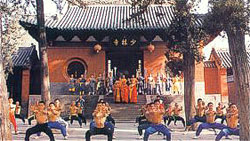|
|
|||
THE MYTHICAL SHAOLIN
The construction of the first Shaolin Temple (Hunan Province) was commissioned by Emperor Xiao Wen around 495 AD. The Emperor ordered the temple built for the benefit of an Indian Buddhist monk named Buddhabhadra, or Ba Tuo in Chinese.
It
is said that the first Shaolin martial arts school started when
Bodhidharma (Ta-Mo, BaMo or Da Mo in different Chinese
dialects), came to the Shaolin Temple or Young Forest Temple,
after being banished in the south by Emperor Lian Wu Ti of Liang.
He was banished after the emperor asked him, "What merit have I
gained by all my efforts?" referring to his building of new
temples and pagodas, restorations, and giving money to the
Sangha (Buddhist brotherhood), along with offerings in all major
temples throughout the land. TA-MO answered, "Your majesty,
through your efforts, you have gained no merit at all." Arriving
at the Temple around 520 AD, Bodhidharma sought to become
enlightened. He found a nearby cave and meditated for nine
Another story is dated two decades before the arrival of TA-MO (Bodhidharma)
and dictates that two of Abbott BA Tuo's disciples, Hui Guang
and Seng Chou, helped to
By the end of 6th century AD (around 570 AD), the Shaolin ethic was tarnished when a few renegade monks were charged for evil doings, and using their skills for wrong doing. The Temple was temporarily closed. But by the beginning of the 6th Century, their martial skills and integrity went hand and hand. The new Emperor (around 600 AD) opened up the temple. The first test of the Shaolin epic came soon after. They were called upon (618 - 620 AD) to save Prince Li Shimin against the oppression of the Sui Dynasty army. History says that 13 Shaolin Monks fought off an entire brigade! Their mission a success, they were rewarded with much food and land, and granted the right to drink wine and eat meat. In return, Li helped by increasing the monks to 1000 by adding 500 monk soldiers.
Through the preexisting exercises, martial arts, and people visiting the Temple - whether it be Ming sympathizers fighting against the Manchus, or other martial artists - the Shaolin Monks absorbed what was useful and disregarded what they considered useless. Throughout the centuries they continued to fight for the emperors, for the common man, and for the common good. The Shaolin monastery was burned down several times in the next centuries. These setbacks only strengthened the will of the dedicated monks. Other temples were built to accommodate the growing number of monks, and to house the ones that were misplaced by the temple burning. The monks began returning to their roots. They abolished the utilization of weapons. "We may not have knives, so every finger is a dagger, without spears, every arm must be a spear, and every hand a sword." Other temples (Fukien, Wu Dang, Guandong, E Mei Shan and more) were built to accommodate the growing number of monks, plus house the ones that were misplaced by the temple burning. Unfortunately, they were attacked as well.
The
legacy of Shaolin fell during the Ching Dynasty (1644 - 1911)
when the ruling foreign class The Manchu's - the ruling foreign
class at the time - kept a wary eye on them, even forbidding
them to practice martial arts. The Ching Emperors appointed
Abbots to over see these fighti
In 1949, the Temple had eras of peace with the end of the Civil War and the victory of the Communists and Mao Tse-Tung. However, this was short lived. The Communist government soon outlawed the practice of martial arts as "counterrevolutionary" and a threat to the state. Monks practiced late at night high in the mountains and other various hidden places to avoid detection and imprisonment. These dedicated practitioners kept Shaolin from utter extinction, but even more perilous times were approaching. The Cultural Revolution led by Madame Mao followed in the 1960's. Young soldiers attacked all vestiges of China's cultural past, including the Shaolin Temple. Teachers, fine artists and learned professionals (among others) were imprisoned and killed in the name of the revolution. Of all the Shaolin monks, four refused to flee to safety and chose to remain at the burnt wreckage of the temple. They were beaten and imprisoned for their courageous act of defiance, but released once the madness of the revolution passed. Three of these monks still live at the temple today.
After the Cultural Revolution, the Chinese government reorganized and began to cultivate China's cultural past. The government began a slow process of rebuilding the Hunan Temple. When it became public that the Shaolin Temple was now enrolling students, literally tens of thousands of young Chinese children ran away from home to learn the secret fighting techniques of Shaolin Kung Fu. Many were turned away. And now the new genesis of Shaolin is upon us. It began after the release of the film Shaolin Temple (Shaolinsi) in 1982, starring Jet Li and Sun Jianyun. In 1988, the Shaolin Temple Wushu training center was open as a center for foreign guests to train with Shaolin Monks. The resurgence of popularity from films and tourism has helped to fund continued restoration and renovation of the Shaolin Temple. For 1500 years, the Shaolin monks would, and still, absorb what is useful and disregard what they considered useless. Throughout the centuries they continued to fight for the emperors, for the common man, for the common good.
|
|||
|
Robert Daniels |
|||
|
|
|||
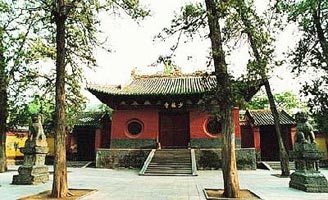
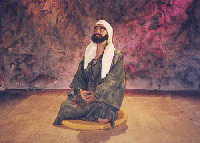 years,
constructing the Chan Buddhist philosophy of China which would
later become Zen Buddhism in Japan. During this visit he wrote
"Shi Sui Ching" based on Chan Buddhism. A second book "Yi Jin
Jing," evolved after seeing the monks fall asleep during
meditation and develop bad circulation from crossing their legs.
TA-MO (Bodhidharma) also noticed that their muscles were soft,
and they displayed symptoms of improper nutrition. This book
instructed them in exercises to vitalize their bodies and minds
and ultimately develop their full Qi (or Chi, vital energy)
potential, and some martial arts movements. They gave monks the
ability to meditate for longer periods of time, which in turn
made better Buddhists. This book was divided into three sections
"The Muscle Change Classic," "The Marrow Washing Course," & "The
Eighteen Hand Movements of the Enlightened One," which is the
basis for most internal styles.
years,
constructing the Chan Buddhist philosophy of China which would
later become Zen Buddhism in Japan. During this visit he wrote
"Shi Sui Ching" based on Chan Buddhism. A second book "Yi Jin
Jing," evolved after seeing the monks fall asleep during
meditation and develop bad circulation from crossing their legs.
TA-MO (Bodhidharma) also noticed that their muscles were soft,
and they displayed symptoms of improper nutrition. This book
instructed them in exercises to vitalize their bodies and minds
and ultimately develop their full Qi (or Chi, vital energy)
potential, and some martial arts movements. They gave monks the
ability to meditate for longer periods of time, which in turn
made better Buddhists. This book was divided into three sections
"The Muscle Change Classic," "The Marrow Washing Course," & "The
Eighteen Hand Movements of the Enlightened One," which is the
basis for most internal styles.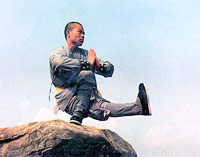 start the system with preexisting exercises and martial arts.
Abbot BA Tuo (the head and first Shaolin Temple Abbot) was
always enamored with the Chinese martial arts, and actually
recruited individuals skilled in them. BA Tua had witnessed an
incredible of balance and agility feat by Hui Guang. Hui kicked
a shuttle cock 500 times while balancing on a high wall. A fall
would have been fatal. Seng Chou had an extraordinary memory
(memorizing the most difficult sutras in one reading), and was
extremely strong and skilled in the martial arts. He enjoyed
demonstrating his skills in wrestling and martial art
techniques, and took on all who contested him. It was said no
one could beat him.
start the system with preexisting exercises and martial arts.
Abbot BA Tuo (the head and first Shaolin Temple Abbot) was
always enamored with the Chinese martial arts, and actually
recruited individuals skilled in them. BA Tua had witnessed an
incredible of balance and agility feat by Hui Guang. Hui kicked
a shuttle cock 500 times while balancing on a high wall. A fall
would have been fatal. Seng Chou had an extraordinary memory
(memorizing the most difficult sutras in one reading), and was
extremely strong and skilled in the martial arts. He enjoyed
demonstrating his skills in wrestling and martial art
techniques, and took on all who contested him. It was said no
one could beat him.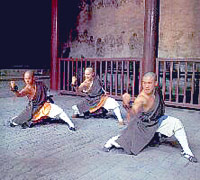
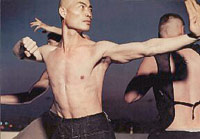 ng monks. The monks were
suppressed, belittled, and told to live a more secluded life.
These difficult and dangerous times gave birth to secret
societies, also known as the Triads. Their motto was "Restore
the Ming, Destroy the Ching." Nevertheless, Shaolin thrived
within the pit of darkness. The monks that fled hid in other
temples, opera boats, & other countries (Japan & Korea, etc.).
They became cooks, waiters, farmers, and continued to pass down
what they were taught. Many other styles of Kung Fu developed
within their secret societies, including Hung Gar & Wing Chun.
Through time, these monks would again thrive and play a part in
expelling the Manchu's out of China.
ng monks. The monks were
suppressed, belittled, and told to live a more secluded life.
These difficult and dangerous times gave birth to secret
societies, also known as the Triads. Their motto was "Restore
the Ming, Destroy the Ching." Nevertheless, Shaolin thrived
within the pit of darkness. The monks that fled hid in other
temples, opera boats, & other countries (Japan & Korea, etc.).
They became cooks, waiters, farmers, and continued to pass down
what they were taught. Many other styles of Kung Fu developed
within their secret societies, including Hung Gar & Wing Chun.
Through time, these monks would again thrive and play a part in
expelling the Manchu's out of China.